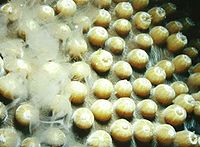
External fertilization
Encyclopedia

Internal fertilization
In mammals, internal fertilization is done through copulation, which involves the insertion of the penis into the vagina. Some other higher vertebrate animals reproduce internally, but their fertilization is cloacal.The union of spermatozoa of the parent organism. At some point, the growing egg or...
takes place inside the female after insemination
Insemination
Insemination is the deliberate introduction of sperm into the uterus of a mammal or the oviduct of an oviparous animal for the objective of impregnating a female for reproduction...
through copulation.
In sexual reproduction
Sexual reproduction
Sexual reproduction is the creation of a new organism by combining the genetic material of two organisms. There are two main processes during sexual reproduction; they are: meiosis, involving the halving of the number of chromosomes; and fertilization, involving the fusion of two gametes and the...
, there must be some way of getting the sperm to the egg. Since sperm are designed to be mobile in a watery environment (they have tails and are streamlined), aquatic animals can make use of the water in which they live. Many plants make use of external fertilization, especially ones without bright flowers or other means of attracting animals.
In many aquatic animals such as coral
Coral
Corals are marine animals in class Anthozoa of phylum Cnidaria typically living in compact colonies of many identical individual "polyps". The group includes the important reef builders that inhabit tropical oceans and secrete calcium carbonate to form a hard skeleton.A coral "head" is a colony of...
or hydra
Hydra (genus)
Hydra is a genus of simple fresh-water animal possessing radial symmetry. Hydras are predatory animals belonging to the phylum Cnidaria and the class Hydrozoa. They can be found in most unpolluted fresh-water ponds, lakes, and streams in the temperate and tropical regions and can be found by...
, eggs and sperm are simultaneously shed into the water, and the sperm swim through the water to fertilize the egg in a process known as broadcast fertilization. In many fish species, including salmon
Salmon
Salmon is the common name for several species of fish in the family Salmonidae. Several other fish in the same family are called trout; the difference is often said to be that salmon migrate and trout are resident, but this distinction does not strictly hold true...
, the female will deposit unfertilized eggs in the substrate and the male will swim by and fertilize them. External fertilization uses or needs thousands of sperm cells

